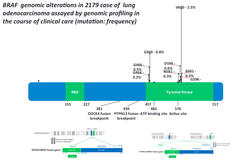Large-scale genomic evaluation of tumour samples in the course of clinical care from over 3000 consecutive patients with lung cancer revealed that BRAF mutations occur in lung adenocarcinoma (LADCA) and non-squamous non-smallcell lung cancer (NSCLC) but not in smallcell lung cancer (SCLC) and very rarely in squamous cell cancer (SCC) of the lung.
Findings reported at the European Cancer Congress (ECC 2015), convening in Vienna, Austria, 25 - 29 September 2015, contribute to the knowledge of which BRAF genetic alterations are present in types of lung cancer that may impact upon responsiveness to treatment.
Oncogenic variations in BRAF were detected in 6.1% of LADCA, 3.2% of non-squamous NSCLC and 0.8% of SCC patient tumour samples. No BRAF alterations were detected in patient samples of SCLC, which had the smallest sample size of 201 cases.
Siraj Ali, MD PhD Clinical Development, Foundation Medicine, Inc., Cambridge, USA, presented findings during the Proffered Papers: Lung Cancer Session on 28 September 2015.
Dr. Ali explained that previous reports estimate that BRAF V600E mutations are found in approximately 2-3% of patients with NSCLC. These driver mutations typically are mutually exclusive of other oncogenic drivers. In addition, a subset of other BRAF genetic alterations, including certain fusions, may also be oncogenic as they activate either the kinase domain or downstream targets.
This study aimed to characterise the incidence of BRAF V600E mutations and other BRAF alterations in four types of lung cancer.
To fully characterise the extent of BRAF mutations in lung cancer and the posited oncogenic activity of these genetic alterations, investigators reviewed 3300 consecutive lung cancer cases in the course of clinical care for alterations thought to activate BRAF using comprehensive genomic profiling (CGP). In all, 2179 LADCA samples, 535 non-squamous NSCLC, 385 SCC and 201 SCLC tumour samples were analysed.
The investigators extracted DNA from 40 microns of formalin-fixed paraffin embedded (FFPE) sections taken from lung cancer cases. CGP was performed on hybridisation-captured, adaptor ligation based libraries to a mean coverage depth of >500X for 3,769 exons of 315 cancer-related genes plus selected introns from 28 genes that are known to be frequently rearranged in cancer. The results were evaluated for all classes of genomic alterations (GA). Clinically relevant genomic alterations (CRGA) were defined as GA linked to the response to drugs that were already on the market or under evaluation in mechanism driven clinical trials.
BRAF alterations were detected more often in this series than reported in the literature
V600 was the most frequently occurring mutation and was detected in 2.5% of LADCA and 0.4% of non-squamous NSCLC samples. The other alterations more frequently identified were G469 in 0.8% versus 1.3%, G466 at 0.5% versus 0.6% and D594 at 0.6% versus 0.0% of LADCA and non-squamous NSCLC samples, respectively.
Alterations in BRAF G469 and D594 were detected in 0.3% of SCC samples. Alterations occurring in less than 0.5% of tumour types included G464, N581, and K601.
Two LADCA samples harboured novel fusions, DOCK4-BRAF and PTPN13-BRAF; of these, one patient developed acquired resistance to vemurafenib, but response was restored with the addition of everolimus.
Conclusions
The authors concluded that CGP can be used successfully to identify all classes of BRAF alterations in NSCLC, which reached nearly a 5% frequency of alteration. The rates of specific alterations differed between histologic subtypes, with LADCA harbouring approximately 50% of BRAF V600E mutations compared to non-squamous NSCLC, which harboured 87.5% of intermediately activating BRAF alterations, but only 12.5% of BRAF V600E alterations.
Only 3 samples out of 385 (<1%) SCC harboured BRAF mutations, and no BRAF alterations were seen in SCLC samples, which suggests that limited benefit can be obtained from BRAF testing in SCLC and potentially SCC as well.
They noted that clinical trials are ongoing for BRAF V600E inhibitors in NSCLC, and suggested that patients with NSCLC harbouring other activating alterations of BRAF may also benefit from this therapy.
Reference
3007 Comprehensive genomic profiling characterizes the cpectrum of non-V600E activating BRAF alterations Including BRAF fusions in lung cancer


